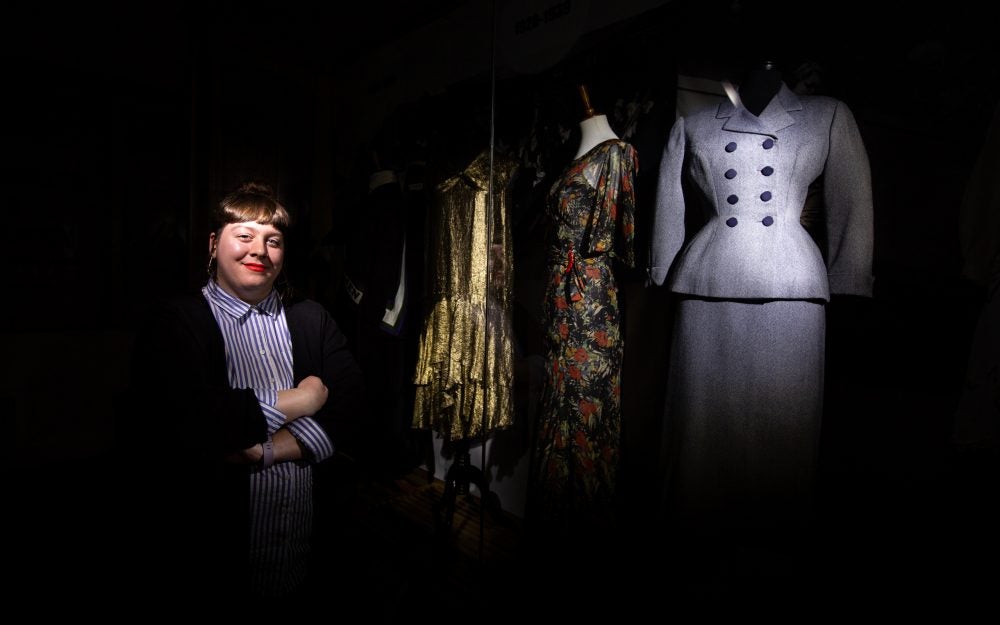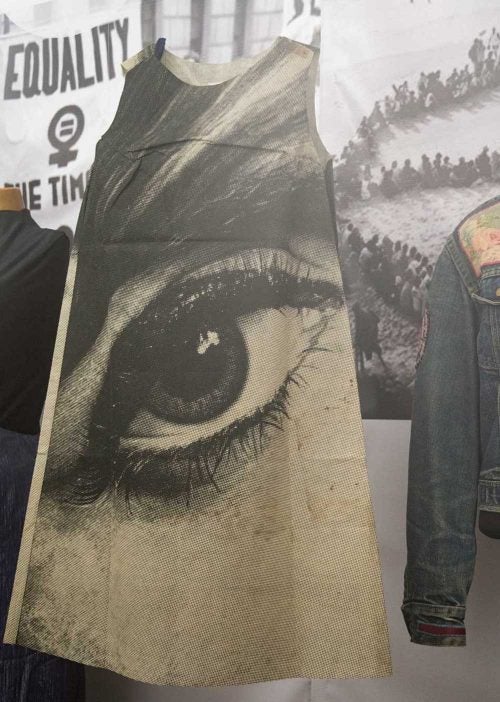
Miranda Dicenzo ’11, MS ’18, curator of “Feminism and Fashion in the 20th Century: A Material Culture Study”
Not so long ago a woman’s preference for pants over a skirt was viewed as a political act.
If you think we’re talking about the suffragette movement or another distant period, think again. Try 2016 and presidential candidate Hillary Clinton. Google “Hillary Clinton’s pants” and you’ll get 9,360,000 results (“Hillary Clinton pantsuit” nets a more modest 392,000). President Trump’s suits garnered half as much attention.
Such interest in Clinton’s wardrobe choices comes as no surprise to Miranda Dicenzo ’11, MS ’18. Dicenzo is the curator of “Feminism and Fashion of the 20th Century: A Material Culture Study,” on exhibit in Quinn Hall’s Textile Gallery through December. The exhibit traces the women’s rights movement in America through examination of fashion from the 1870s to the 1990s. Corsets, pants, mini-skirts, bras, no bras, jelly bracelets, leggings, lace, and ripped tights—American women’s fashion asserts that a woman’s sartorial sense often reflects a rebellious, independent, and progressive mindset. And it can be mapped to the first, second, and third waves of American feminism, Dicenzo said.
Dicenzo assembled the exhibit as part of her research for her master’s in textiles, fashion merchandising, and design. She specializes in historic textiles. Dicenzo’s exhibit features 17 items dating from the 1870s to the 1990s. In total, there are 11 historic outfits and two fairly contemporary ensembles: one punk, one grunge. URI’s historic textile and costume collection contains more than 16,000 objects in total from cultures worldwide.
Inside the Exhibit
Items on view include a bustled hoop skirt from the 1870s, an 1890s-era Royal Worcester corset, a metallic gold evening dress from the 1920s, silk pajamas from the 1930s, and a 1960s-era paper dress, the first clothing designed to be disposable. Arranged chronologically, the pieces together tell a story of restrictions, schisms, and rebellions as restrictive, ultra-feminine garments yield ground to pants, suits, and jeans. For instance, the juxtaposition of a circa 1920 silk blouse with pintucks and mother of pearl buttons with the roomy 1930s-era silk pajamas illustrates the liberation of the female form and the female mind, Dicenzo said. Wending her way through the exhibit space, Dicenzo tells the tale of each item in isolation and in relation to the others, making for a rich history of the evolution of American feminism.
Example: The 1850s saw some Victorian-era American middle-class women donning trousers for the first time in what has been called the dress reform movement. While it would seem that the dress reform movement and the Women’s Rights Movement (circa 1848 to 1920) would pair well together, dress reformers wearing of bloomers, balloonish trousers, was seen by society as a rejection of gender and not embraced by suffragettes—a political move on their part, Dicenzo said.
“The suffragettes drew a larger crowd wearing fashionable dress,” Dicenzo said. “Then you were seen as a woman rather than a gender-bending figure. Not wearing fashionable dress restricted the movement.”

Subsequent clothing choices by beatniks, hippies, and the punk and grunge movements signal an embracing of fashion and anti-fashion at the same time, Dicenzo said. Beatniks and hippies were reacting to the sartorial sensibility embodied by the young women of the 1960s who looked to Jackie O for inspiration. Punk and grunge were a rejection of ’80s excess.
The exhibit’s final ensemble is a grunge outfit, supplied by the curator herself. And it would seem that it is the punctuation mark to the story of feminism and fashion. Women can wear anything they want now, right?
Maybe. Maybe not.
Fashion and Power
On one wall of the exhibit, there is a quote by Naomi Wolf, author of the New York Times bestseller The Beauty Myth: How Images of Beauty Are Used Against Women. The quote: “The more power women have gained, the more beauty restrictions have been placed on them.”
Dicenzo quotes Margaret Thatcher: “Never trousers, dear. It takes away your power.”
Hillary Clinton’s choice of white pantsuits for her acceptance of the Democratic nomination and her third and final presidential debate had historians making comparisons to the suffragettes, noting that they wore white to assert their purity in the face of detractors’ charges that their cause was immoral. So, consensus is Clinton’s choice was symbolic. But was it prudent?
If pants are too manly and skirts, too feminine, what’s a woman to do? Dicenzo considers the question. Her answer? Clothing choice is about human agency. Clothing choice is about claiming your space in the world. Clothing choice is about finding your voice.
“You’re judged by your clothing. It reflects your political beliefs, your social beliefs. It’s all about choice,” she said. “If there’s anything to be said in this exhibit, it’s that fashion is the greatest communicator.”

Online Collection
Now available online, the Historic Textile and Costume Collection supports teaching in the Department of Textiles, Fashion Merchandising and Design, as well as other departments on campus. Browse hundreds of objects in the collections and watch for updates as new objects are added.

